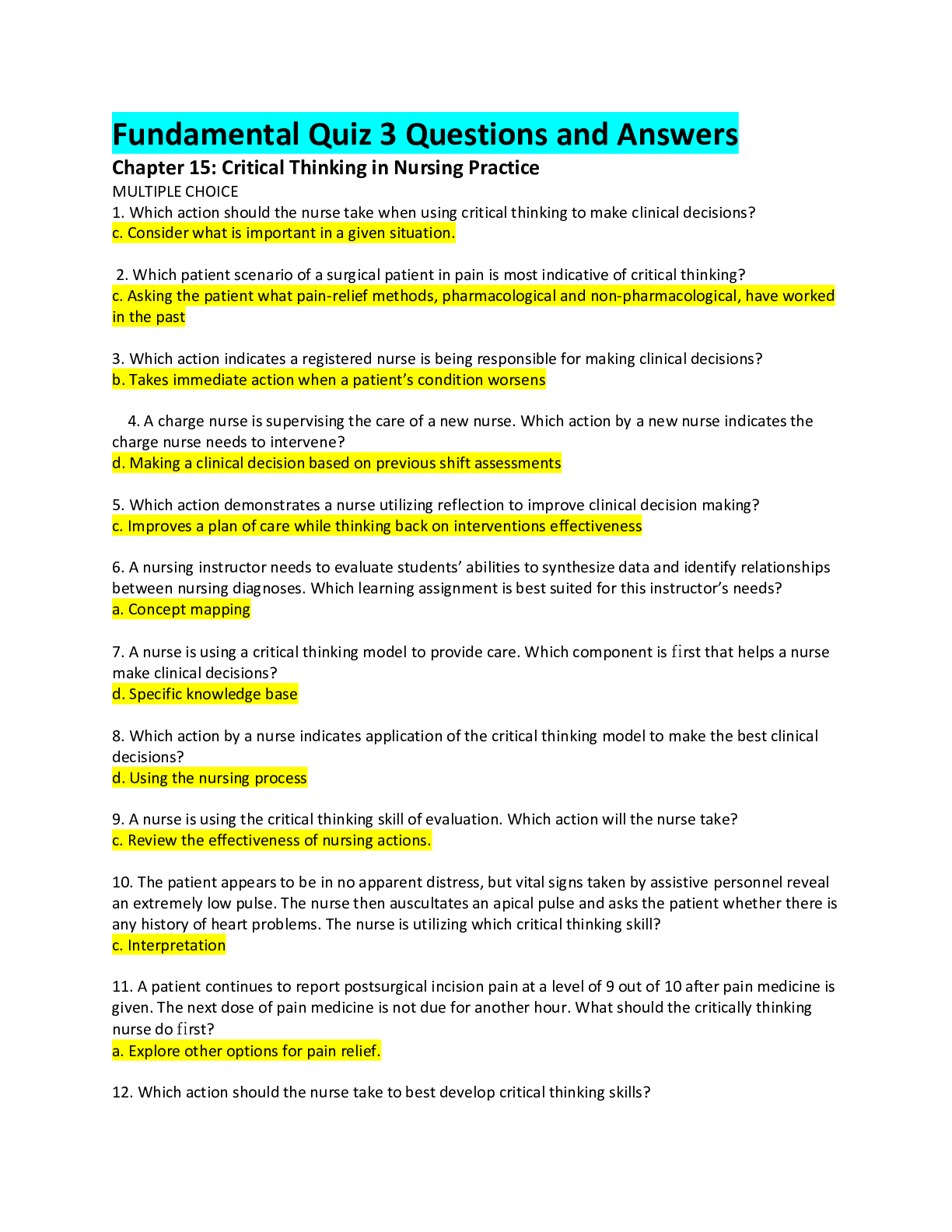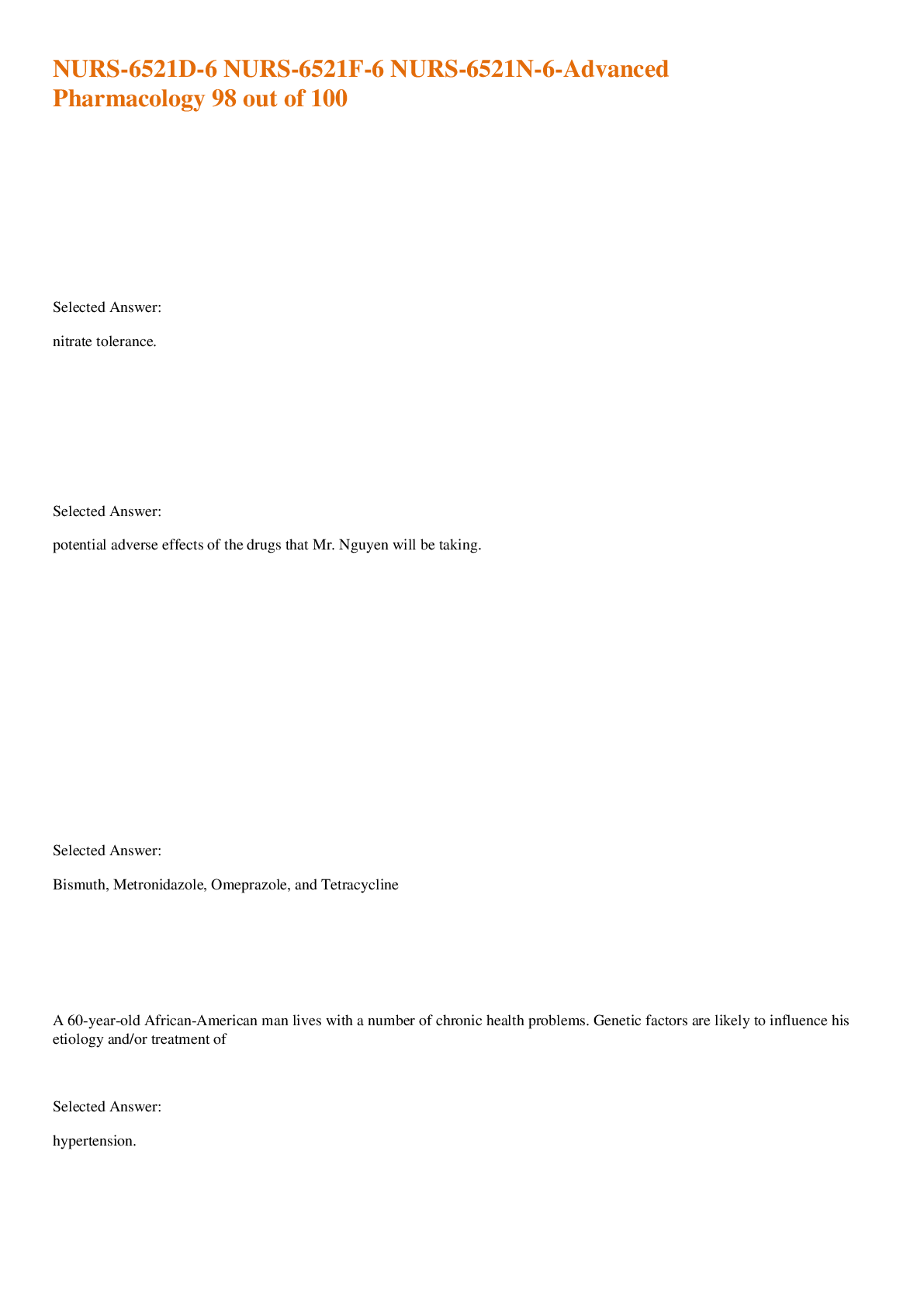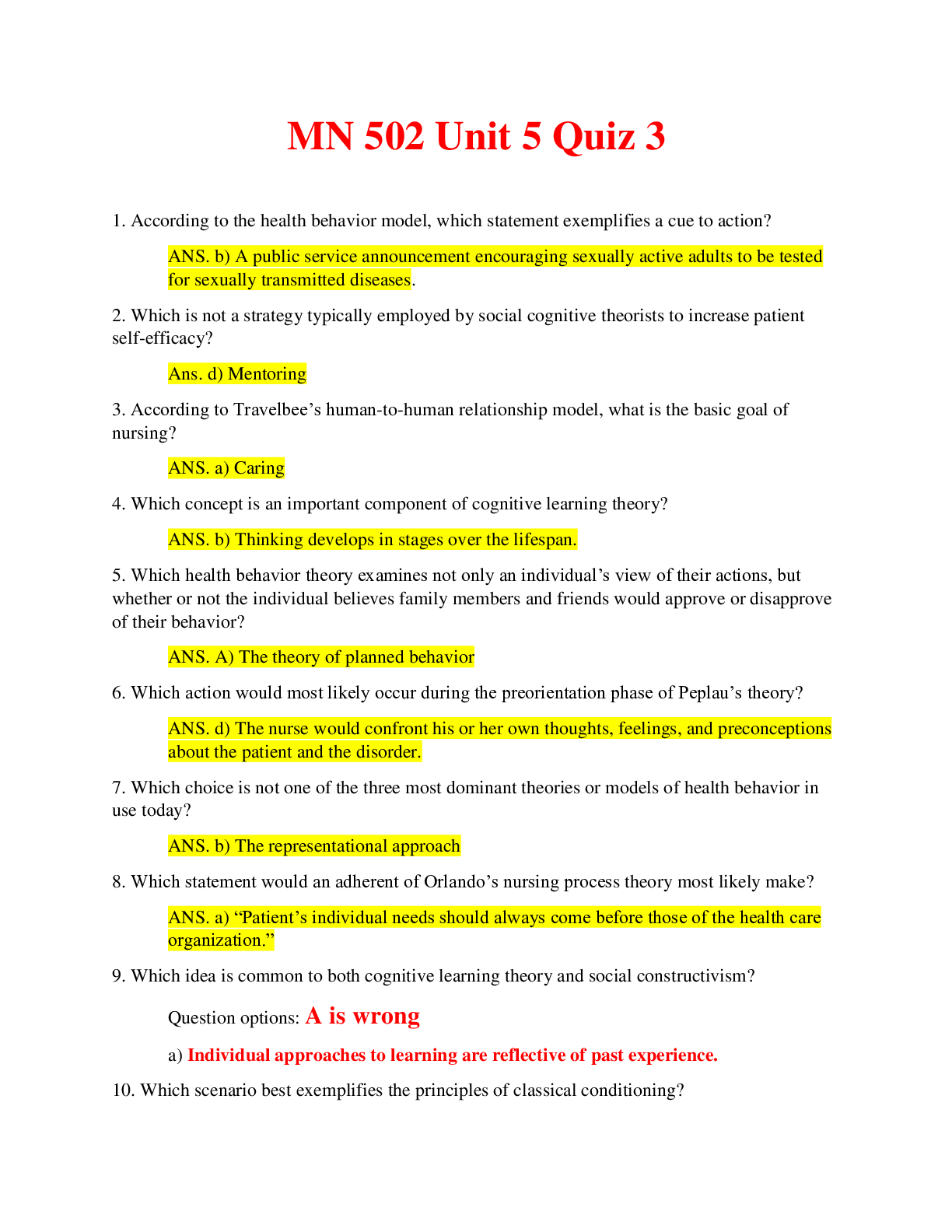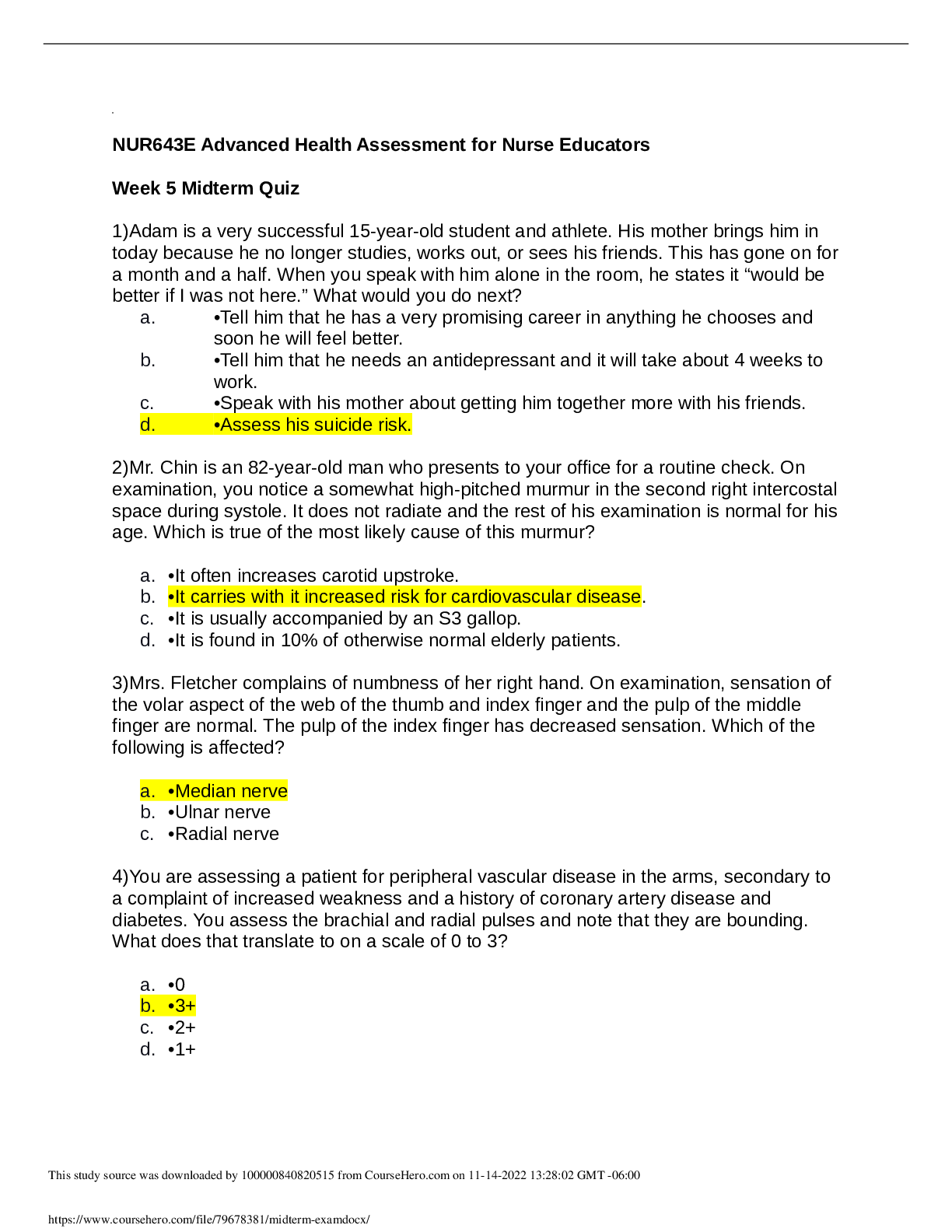*NURSING > EXAM > Fundamental Quiz 3 Questions and Answers|Concorde Career Colleges, Lauderdale Lake - NURSING 11456 F (All)
Fundamental Quiz 3 Questions and Answers|Concorde Career Colleges, Lauderdale Lake - NURSING 11456 Fundamental Quiz 3.
Document Content and Description Below
Fundamental Quiz 3 Questions and Answers Chapter 15: Critical Thinking in Nursing Practice MULTIPLE CHOICE 1. Which action should the nurse take when using critical thinking to make clinical decisions... ? 2. Which patient scenario of a surgical patient in pain is most indicative of critical thinking? 3. Which action indicates a registered nurse is being responsible for making clinical decisions? 4. A charge nurse is supervising the care of a new nurse. Which action by a new nurse indicates the charge nurse needs to intervene? 5. Which action demonstrates a nurse utilizing reflection to improve clinical decision making? 6. A nursing instructor needs to evaluate students’ abilities to synthesize data and identify relationships between nursing diagnoses. Which learning assignment is best suited for this instructor’s needs? 7. A nurse is using a critical thinking model to provide care. Which component is first that helps a nurse make clinical decisions? 8. Which action by a nurse indicates application of the critical thinking model to make the best clinical decisions? 9. A nurse is using the critical thinking skill of evaluation. Which action will the nurse take? 10. The patient appears to be in no apparent distress, but vital signs taken by assistive personnel reveal an extremely low pulse. The nurse then auscultates an apical pulse and asks the patient whether there is any history of heart problems. The nurse is utilizing which critical thinking skill? 11. A patient continues to report postsurgical incision pain at a level of 9 out of 10 after pain medicine is given. The next dose of pain medicine is not due for another hour. What should the critically thinking nurse do first? 12. Which action should the nurse take to best develop critical thinking skills? 13. While caring for a hospitalized older-adult female post hip surgery, the nurse is faced with the task of inserting an indwelling urinary catheter, which involves rotating the hip into a contraindicated position. Which action should the nurse take? 14. The nurse enters a room to find the patient sitting up in bed crying. How will the nurse display a critical thinking attitude in this situation? 15. A patient is having trouble reaching the water fountain while holding on to crutches. The nurse suggests that the patient place the crutches against the wall while stabilizing him or herself with two hands on the water fountain. Which critical thinking attitude did the nurse use in this situation? 16. A nurse is pulled from the surgical unit to work on the oncology unit. Which action by the nurse displays humility and responsibility? 17. A nurse is using professional standards to inᴀ밄uence clinical decisions. What is the rationale for the nurse’s actions? 18. A nurse who is caring for a patient with a pressure ulcer applies the recommended dressing according to hospital policy. Which standard is the nurse following? 19. A nurse is reviewing care plans. Which finding, if identified in a plan of care, should the registered nurse revise? 20. In which order will the nurse use the nursing process steps during the clinical decision-making process? 1. Evaluating goals 2. Assessing patient needs 3. Planning priorities of care 4. Determining nursing diagnoses 5. Implementing nursing interventions 1. Which Findings will alert the nurse that stress is present when making a clinical decision? (Select all that apply.) Chapter 35: Sexuality Potter et al.: Fundamentals of Nursing, 9th Edition MULTIPLE CHOICE 1. A nurse is caring for a 15-year-old who in the past 6 months has had multiple male and female sexual partners. Which response by the nurse will be most effective? 2. A nurse is caring for a patient who expresses a desire to have an elective abortion. The nurse’s religious and ethical values are strongly opposed. How should the nurse best handle the situation? 3. Which patient is most in need of a nurse’s referral to adoption services? 4. The nurse is caring for a patient who recently had unprotected sex with a partner who has HIV. Which response by the nurse is best? 5. An 18-year-old male patient informs the nurse that he isn’t sure if he is homosexual because he is attracted to both genders. Which response by the nurse will help establish a trusting relationship? 6. A nurse is caring for a 35-year-old female patient who recently started taking antidepressants after repeated attempts at fertility treatment. The patient tells the nurse, “I feel happier, but my sex drive is gone.” Which nursing diagnosis has the highest priority? 7. A nurse is using the PLISSIT model when caring for a patient with dyspareunia from diminished vaginal secretions. The nurse suggests using water-soluble lubricants. Which component of PLISSIT is the nurse using? 8. A patient who has had several sexual partners in the past month expresses a desire to use a contraceptive. Which contraceptive method should the nurse recommend? 9. A woman who has been in a monogamous relationship for the past 6 months presents to clinic with herpes on her labia. The patient is distraught because her partner must have cheated on her. Which response by the nurse is most effective in establishing an open rapport with a patient? 10. A nurse is preparing a community class about sexually transmitted infections. Which primary group will the nurse focus on for this class? 11. The nurse is leading a seminar about menopause and age-related changes. Which response from a group member indicates the nurse needs to follow up? 12. A patient who had a colostomy placed 1 month ago is feeling depressed and does not want to participate in sexual activities anymore. The patient is afraid that the partner does not want sex. The patient is afraid the ostomy is physically unattractive. Which initial nursing intervention will be most effective in helping this patient resume sexual activity? 13. A mother brings her 12-year-old daughter into a clinic and inquiries about getting a human papillomavirus (HPV) vaccine that day. Which information will the nurse share with the mother and daughter about the HPV vaccine? 14. A parent asks about the human papillomavirus (HPV) vaccine. Which information will the nurse include in the teaching session? 15. A nursing student is providing education to a group of older adults who are in an independent living retirement village. Which statement made by the nursing student requires the nurse to intervene? 16. A nurse is interviewing a woman who uses a diaphragm. Which information from the patient will require the nurse to follow up? 17. A nurse is conducting a sexual assessment. Which question is appropriate for the nurse to ask? 18. A 15-year-old patient is concerned because her mother wants her to receive the human papillomavirus (HPV) vaccination, but the patient is unsure if she wants it. Which response by the nurse is most therapeutic? 19. A nurse is reviewing a patient’s history. Which priority finding will alert the nurse to assess the patient for possible sexual dysfunction? 20. A nurse is assessing a child for sexual abuse. Which assessment findings will the nurse expect? 21. The nurse is teaching a patient how to use a condom. Which instructions will the nurse provide? 22. A nurse is caring for a patient with dyspareunia. In which order will the nurse provide care, starting with the first step? 1. Determine which signs and symptoms of dyspareunia the patient has. 2. Mutually decide upon goals and objectives for dyspareunia. 3. Ask the patient if the dyspareunia is improving. 4. Develop a nursing diagnosis for the patient. 5. Use resources to help resolve the problem. MULTIPLE RESPONSE 1. An older couple expresses concern because they are easily fatigued during sexual intercourse and cannot reach climax. Which strategies to increase sexual stamina will the nurse oᴀ洅er? (Select all that apply.) a. Plan sexual activity around a time when the couple feels rested. e. Avoid alcohol and tobacco. f. Eat well-balanced meals. 36: Spiritual Health MULTIPLE CHOICE 1.A co-worker asks the nurse to explain spirituality. What is the nurse’s best response? 2.The nurse is caring for a patient who is an agnostic. Which information should the nurse consider when planning care for this patient? 3.The nurse is caring for an Islam patient who wants a snack. Which action by the nurse is most appropriate? 4. A nurse is teaching a patient how to meditate. Which information from the patient indicates effective learning? 5.The nurse is admitting a patient to the hospital. The patient is a very spiritual person but does not practice any specific religion. How will the nurse interpret this finding? 6.A nurse hears the following comments from different patients. Which patient comment does the nurse identify as faith? 7.A nurse is caring for a Hindu patient. Which action will the nurse take? 8.The nurse is caring for a patient with a chronic illness who is having conflicts with beliefs. Which health care team member will the nurse ask to see this patient? 9.The nurse is caring for a patient with a terminal disease. The nurse sits down and lightly touches the patient’s hand. Which technique is the nurse using? 10.The nurse and the patient have the same religious affiliation. Which action will the nurse take? 11.A nurse makes a connection with the patient when providing spiritual care. Which type of connectedness did the nurse experience? 12.The patient is admitted with chronic anxiety. Which action is most appropriate for the nurse to take? 13.In caring for the patient’s spiritual needs, the nurse asks 20 questions to assess the patient’s relationship with God and a sense of life purpose and satisfaction. Which method is the nurse using? 14.A male patient in stable condition is in the intensive care unit (ICU) and is asking to see his spouse and two daughters. What should the nurse do? 15.The nurse is caring for a patient who has been diagnosed with a terminal illness. The patient states, “I just don’t feel like going to work. I have no energy, and I can’t eat or sleep.” The patient shows no interest in taking part in the care by saying, “What’s the use?” Which response by the nurse is best? 16.The patient is having a difficult time dealing with an AIDS diagnosis. The patient states, “It’s not fair. I’m totally isolated from God and my family because of this. Even my father hates me for this. He won’t even speak to me.” What should the nurse do?. 17.The nurse is caring for a group of patients. Which patient will the nurse see first? 18.A nurse is providing spiritual care to patients. Which action is essential for the nurse to take? MULTIPLE RESPONSE 1.A nurse is evaluating a patient’s spiritual care. Which areas will the nurse include in the evaluation process? (Select all that apply.) a. Review the patient’s view of the purpose in life. b. Ask whether the patient’s expectations were met. c. Discuss with family and friends the patient’s connectedness. d. Review the patient’s self-perception regarding spiritual health. 2.Spiritual distress has been identified in a patient who has been diagnosed with a chronic illness. Which interventions will the nurse add to the care plan? (Select all that apply.) MATCHING A nurse is providing spiritual care to a group of patients. Match the group to their belief. a. Nature controls life and health. b. Organ transplantation or donation is not considered. c. Observance of the Sabbath is important. d. Past sins cause illness. e. Nonhuman spirits invading the body cause illness. 37: The Experience of Loss, Death, and Grief MULTIPLE CHOICE 1. A nurse encounters a family who experienced the death of their adult child last year. The parents are talking about the upcoming anniversary of their child’s death. The nurse spends time with them discussing their child’s life and death. Which nursing principle does the nurse’s action best demonstrate? 2. A cancer patient asks the nurse what the criteria are for hospice care. Which information should the nurse share with the patient? 3. A terminally ill patient is experiencing constipation secondary to pain medication. Which is the best method for the nurse to improve the patient’s constipation problem? 4. A severely depressed patient cannot state any positive attributes to life. The nurse patiently sits with this patient and assists the patient to identify several activities the patient is actually looking forward to in life. Which spiritual concept is the nurse trying to promote? 5. In preparation for the eventual death of a female hospice patient of the Muslim faith, the nurse organizes a meeting of all hospice caregivers. A plan of care to be followed when this patient dies is prepared. Which information will be included in the plan? 6. Family members gather in the emergency department after learning that a family member was involved in a motor vehicle accident. After learning of the family member’s unexpected death, the surviving family members begin to cry and scream in despair. Which phase does the nurse determine the family is in according to the Attachment Theory? 7. A nursing assistive personnel (NAP) is caring for a dying patient. Which action by the NAP will cause the nurse to intervene? 8. An Orthodox Jewish rabbi has been pronounced dead. The nursing assistive personnel respectfully ask family members to leave the room and go home as postmortem care is provided. Which statement from the supervising nurse is best? 9. A palliative team is caring for a dying patient in severe pain. Which action is the priority? 10. A veteran is hospitalized after surgical amputation of both lower extremities owing to injuries sustained during military service. Which type of loss will the nurse focus the plan of care on for this patient? 11. “I know it seems strange, but I feel guilty being pregnant after the death of my son last year,” said a woman during her routine obstetrical examination. The nurse spends extra time with this woman, helping her realize bonding with this unborn child will not mean she is replacing the one who died. Which nursing technique does this demonstrate? 12. A patient has had two family members die during the past 2 days. Which coping strategy is most appropriate for the nurse to suggest to the patient? 13. A female nurse is called into the supervisor’s office regarding her deteriorating work performance since the loss of her spouse 2 years ago. The woman begins sobbing and says that she is “falling apart” at home as well. Which type of grief is the female nurse experiencing? 14. A nurse is caring for a patient in the last stages of dying. Which finding indicates the nurse needs to prepare the family for death? 15. The mother of a child who died recently keeps the child’s room intact. Family members are encouraging her to redecorate and move forward in life. Which type of grief will the home health nurse recognize the mother is experiencing? 16. A nurse is caring for a dying patient. One of the nurse’s goals is to promote dignity and validation of the dying person’s life. Which action will the nurse take to best achieve this goal? 17. A nurse is caring for a dying patient. When is the best time for the nurse to discuss end-of-life care? 18. A nurse is providing postmortem care. Which action will the nurse take? 19. A nurse lets the transplant coordinator make a request for organ and tissue donation from the patient’s family. What is the primary rationale for the nurse’s action? 20. A patient cancels a scheduled appointment because the patient will be attending a Shivah for a family member. Which response by the nurse is best? 21. During a follow-up visit, a female patient is describing new onset of marital discord with her terminally ill spouse to the hospice nurse. Which Kübler-Ross stage of dying is the patient experiencing? 22. A previously toilet trained toddler has started wetting again. A nurse is gathering a health history from the grandparent. Which health history finding will the nurse most likely consider as the cause of the wetting? 23. A patient’s father died a week ago. Both the patient and the patient’s spouse talk about the death. The patient’s spouse is experiencing headaches and fatigue. The patient is having trouble sleeping, has no appetite, and gets choked up most of the time. How should the nurse interpret these findings as the basis for a follow-up assessment? MULTIPLE RESPONSE 1. A nurse is documenting end-of-life care. Which information will the nurse include in the patient’s electronic medical record? (Select all that apply.) 38: Stress and Coping MULTIPLE CHOICE 1. In a natural disaster relief facility, the nurse observes that an older-adult male has a recovery plan, while a 25-year-old male is still overwhelmed by the disaster situation. A nurse is planning care for both patients. Which factors will the nurse consider about the different coping reactions? 2. A woman who was sexually assaulted a month ago presents to the emergency department with reports of recurrent nightmares, fear of going to sleep, repeated vivid memories of the sexual assault, and inability to feel much emotion. Which medical problem will the nurse expect to see documented in the chart? 3. The nurse teaches stress-reduction and relaxation training to a health education group of patients after cardiac bypass surgery. Which level of intervention is the nurse using? 4. A nurse is teaching guided imagery to a prenatal class. Which technique did the nurse describe? 5. After a natural disaster occurred, an emergency worker referred a family for crisis intervention services. One family member refused to attend the services, stating, “No way, I’m not crazy.” What is the nurse’s best response? 6. A preadolescent patient is experiencing maturational stress. Which area will the nurse focus on when planning care? 7. A nurse is caring for a patient with stress and is in the evaluation stage of the critical thinking model. Which actions will the nurse take? 8. An adult male reports new-onset, seizure-like activity. An EEG and a neurology consultant’s report rule out a seizure disorder. It is determined the patient is using conversion. Which action should the nurse take next? 9. A senior college student visits the college health clinic about a freshman student living on the same dormitory floor. The senior student reports that the freshman is crying and is not adjusting to college life. The clinic nurse recognizes this as a combination of situational and maturational stress factors. Which is the best response by the nurse? 10. Despite working in a highly stressful nursing unit and accepting additional shifts, a new nurse has a strategy to prevent burnout. Which strategy will be best for the nurse to use? 11. A female teen with celiac disease continues to eat food she knows will make her ill several hours after ingestion. While planning care, the nurse considers maturational and tertiary-level interventions. Which intervention will the nurse add to the care plan? 12. A trauma survivor is requesting sleep medication because of “bad dreams.” The nurse is concerned that the patient may be experiencing post-traumatic stress disorder (PTSD). Which question is a priority for the nurse to ask the patient? 13. A patient in a motor vehicle accident states, “I did not run the red light,” despite very clear evidence on the street surveillance tape. Which defense mechanism is the patient using? 14. A nurse is teaching the staff about the general adaptation syndrome. In which order will the nurse list the stages, beginning with the first stage? 15. A young male patient is diagnosed with testicular cancer. Which action will the nurse take first? 16. A nurse is teaching the staff about a nursing theory that views a person, family, or community developing a normal line of defense. Which theory is the nurse describing? 17. An adult who was in a motor vehicle accident is brought into the emergency department by paramedics, who report the following in-transit vital signs: Oral temperature: 99.0° F Pulse: 102 beats/min Respiratory rate: 26 breaths/min Blood pressure: 140/106 Which hormones should the nurse consider as the most likely causes of the abnormal vital signs? 18. A nurse is planning care for a patient that uses displacement. Which information should the nurse consider when planning interventions? 19. Which sociocultural finding in the history of a patient will alert the nurse to a possible developmental problem? 20. A nurse is helping parents who have a child with attention-deficit/hyperactivity disorder. Which strategy will the nurse share with the parents to reduce stress regarding homework assignments? MULTIPLE RESPONSE 1. A nurse is assessing a patient with prolonged stress. Which conditions will the nurse monitor for in this patient? (Select all that apply.) [Show More]
Last updated: 2 years ago
Preview 1 out of 12 pages

Buy this document to get the full access instantly
Instant Download Access after purchase
Buy NowInstant download
We Accept:

Reviews( 0 )
$18.50
Can't find what you want? Try our AI powered Search
Document information
Connected school, study & course
About the document
Uploaded On
Sep 19, 2020
Number of pages
12
Written in
Additional information
This document has been written for:
Uploaded
Sep 19, 2020
Downloads
0
Views
121

.png)




















 CARDIOVASCULAR PRESRIBING (113 Questions and Answers) – South University Savannah.png)



